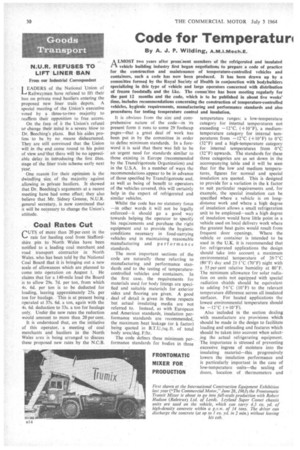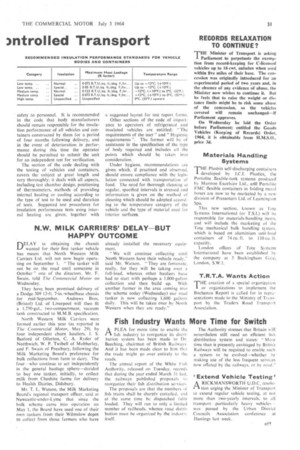Code for Temperaturi mtrolled Transport
Page 32

Page 33

If you've noticed an error in this article please click here to report it so we can fix it.
By A. J. P. Wilding, A.M.I.Mech.E.
ALMOST two years after prom:nent members of the refrigerated and insulated vehicle building industry first began negotiations to prepare a code of practice for the construction and maintenance of temperature-controlled vehicles and containers, such a code has now been produced. It has been drawn up by a committee formed by the Royal Society of Health in conjunction with bodybuilders specializing in this type of vehicle and large operators concerned with distribution of frozen foodstuffs and the Lice. The comm:ttee has been meeting regularly for the past 12 months and the code, which is to be published in about five weeks' time, includes recommendations concerning the construction of temperature-controlled vehicles, hygienic requirements, manufacturing and performance standards and also procedures for testing temperature control and insulation.
It is obvious from the size and comprehensive nature of the code—in its present form it runs to some 29 foolscap pages—that a great deal of work has been put in by the committee in order to define minimum standards. In a foreword it is said that there was felt to be an urgent need for standards similar to those existing in Europe (recommended by the Transfrigoroute Organization) and in the U.S.A. In a number of ways the recommendations appear to be in advance of those specified by Transfrigoroute and, as well as being of benefit to operators of the vehicles covered, this will certainly help in the export of refrigerated and similar vehicles:
Whilst the code has no statutory force —in other words it will not be legally enforced—it should go a good way towards helping the operator to specify his requ:rements and purchase the right equipment and to provide the hygienic conditions necessary in food-carrying vehicles and in maintaining reasonable manufacturing and performance standards.
The most important sections of the code are naturally those referring to manufacturing and performance standards and to the testing of temperaturecontrolled vehicles and containers. In the first case, the requirements for materials used for body linings are specified and suitable materials for exterior sides and flooring are given: A good deal of detail is given in these respects but actual insulating media are not referred to. Instead, as with European and American standards, insulation performance standards are recommended, the maximum heat leakage (or k factor) being quoted in B.T.U./sq. ft. of total body area/deg, F/hr.
The code defines these minimum performance standards for bodies in three
temperature ranges: a low-temperature category for internal temperatures not exceeding —12°C. (+10°F), a mediumtemperature category for internal temperatures from —12°C (+10°F) to 0°C (32°F) and a high-temperature category for internal temperatures from 0°C (32°F) upwards. The standards for these three categories are as set down in the accompanying table and it will be seen that for the low and medium temperatures, figures for normal and special insulation are quoted. This is designed to provide for a variation in the k factor to suit particular requirements and, for example, the special insulation can be specified where a vehicle is on longdistance work and where a high degree of insulation allows a small refrigeration unit to be employed—such a high degree of insulation would have little point in a vehicle used on local delivery work where the greatest heat gains would result from frequent door openings. Where the vehicle or container is intended to be used in the U.K. it is recommended that for, refrigerated applications the design should take into account. a maximum environmental temperature of 26.7°C (80°F) day and 21-1°C (70°F) night with a 55 per cent relative humidity at 80°F. The minimum allowance for solar radiation on units not equipped with special radiation shields should be equivalent to adding 5-6°C (10°F) to the relevant temperature difference across all insulated surfaces. For heated applications the lowest environmental temperature should be —12°C (+10°F).
Also included in the section dealing with manufacture are provisions which should be made in the design to facilitate loading and unloading and features which should be taken_ into account when selecting the actual refrigerating equipment. The importance is stressed of preventing excessive. ingress of moisture into the insulating material—this progressively lowers the insulation performance and is particularly important in the case of low-temperature units—the sealing of doors, location of thermometers and
safety to personnel, it is recommended in •the code that body manufacturers should remain responsible for the insulation performance of all vehicles and containers constructed by them for a period of four months following delivery, and in the event of deterioration in performance during this time the operator should be permitted to submit the unit for an independent test for verification.
The section of the code dealing with the testing of vehicles and containers, covers the subject at great length and very thoroughly; it deals with all aspects, including test chamber design, positioning of thermometers, methods of providing internal heating or cooling according to the type of test to be used and duration of tests. Suggested test procedures for insulation performance tests using internal heating are given, together with a suggested layout for test report forms.
Other sections of the code of importance to operators of refrigerated and insulated vehicles are entitled: "The requirements of the user" and " Hygienic requirements". The former will be of assistance in the specification of the type of body required and includes all the points which should be taken into consideration.
Under hygiene, recommendations are given which, if practised and observed, should ensure compliance with the legislation connected with transportation of food. The need for thorough cleaning at regular, specified intervals is stressed and information is given on the method of cleaning which should be adopted according to the temperature category of the vehicle and the type of material used for interior surfaces.












































































































































